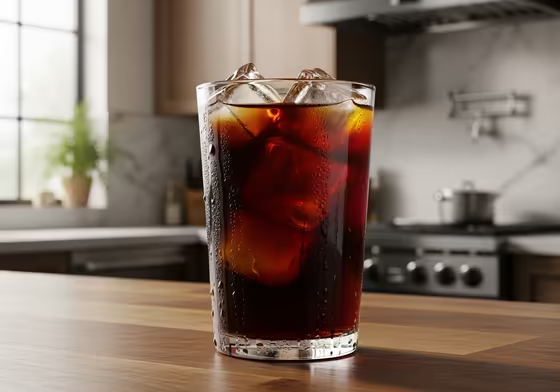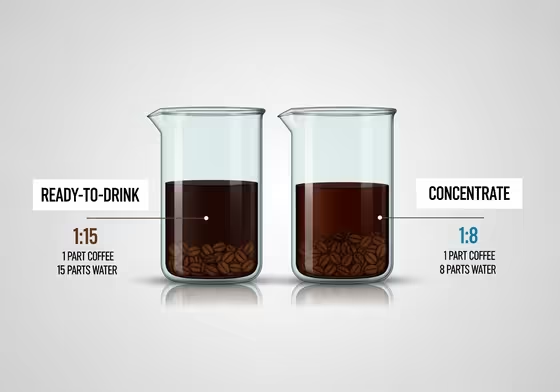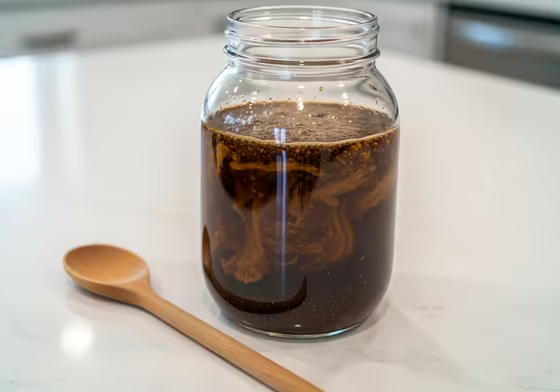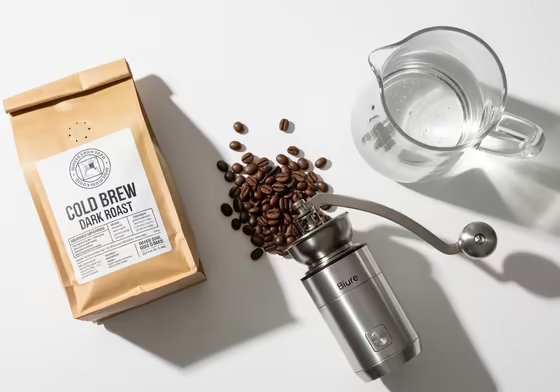How to Make Great Cold Brew Coffee at Home
Cold brew isn't just iced coffee. It’s a different type of drink because of how it's made. Instead of using heat, cold brew uses time to get flavor from the coffee grounds.
The grounds soak in cool water for many hours. This slow process creates a coffee that is super smooth and not very acidic. It often has a rich, chocolatey taste.

But there's a trade-off. Cold water doesn't pull out the same bright or fruity flavors that hot water does. This means cold brew tastes smooth, but it's also less fragrant. To make good cold brew, you need to control the basics like the coffee-to-water ratio and how long it steeps.
What You Need to Start
This section covers the most important parts of making cold brew. We'll start with the coffee-to-water ratio. Then we'll go through the steps and the gear you'll need.
Coffee and Water Ratios
The biggest mistake people make is getting the coffee-to-water ratio wrong. There isn't one perfect ratio. It all depends on what you want to make: a drink that's ready to go or a strong concentrate you need to water down.
Decision 1: Making Ready-to-Drink Coffee
A ready-to-drink cold brew is meant to be poured over ice and enjoyed right away. You don't need to add any more water.
- The Ratio: This recipe uses more water. A good starting point is a 1:15 ratio, which means 1 part coffee to 15 parts water.
- Pros: It’s simple because you don't have to guess how much to water it down. Your coffee might even have a more balanced flavor.
- Cons: It takes up a lot of space in your jar and in the fridge.
Decision 2: Making a Cold Brew Concentrate
A concentrate is a very strong coffee base that you must dilute before drinking. Drinking it straight would be way too strong and have a lot of caffeine.
- The Ratio: This uses much less water. Common ratios are from 1:4 to 1:8. A 1:8 ratio will give you a standard, useful concentrate.
- Pros: It saves a lot of space. You can make a big batch and keep it in the fridge for a week or more. It's also great for iced coffees, cocktails, or even baking.
- Dilution: You have to do this final step. Most people mix 1 part concentrate with 1 or 2 parts water or milk.

It's important to know that making a 1:4 concentrate and adding water is not the same as brewing a 1:8 ready-to-drink batch. When you make a concentrate, the water gets full of coffee flavor very quickly. This makes it harder for the water to pull out more flavor, even if you steep it for a long time.
Using a "Cold Brew Ratio Calculator"
You can find calculators online to make the math easier. Just tell it if you're making a concentrate or a ready-to-drink batch and how much you want to make.
Good calculators also think about water absorption. The dry coffee grounds soak up about twice their own weight in water. This means you get less liquid coffee than the water you started with.
Cold Brew Ratio Quick Guide
| Brew Style | Coffee:Water Ratio (by weight) | Example (100g Coffee) | Taste | How to Serve |
|---|---|---|---|---|
| Strong Concentrate | 1:4 - 1:6 | 400g - 600g water | Very intense and syrupy | Must dilute. Start with 1 part concentrate to 2 parts water or milk. |
| Standard Concentrate | 1:7 - 1:9 | 700g - 900g water | Strong but smooth | Must dilute. Start with 1 part concentrate to 1 part water or milk. |
| Ready-to-Drink (RTD) | 1:12 - 1:18 | 1200g - 1800g water | Balanced and refreshing | No dilution needed. Pour directly over ice. |
A Simple Recipe for Beginners
This recipe works with any simple container, like a big Mason jar or a French press. It uses a 1:8 ratio to make a standard concentrate.

- GRIND: Start with 1 cup of whole coffee beans. Grind them so they are medium-coarse, like the texture of coarse cornmeal. If the grind is too fine, your coffee will be bitter and muddy.
- COMBINE: Put the 1 cup of grounds into a large jar or pitcher. Add 8 cups of cold, filtered water.
- STIR GENTLY: Use a long spoon to gently push all the coffee grounds under the water. You just want to get them all wet. Stirring too hard can make the coffee bitter.
-
STEEP: Cover the jar and let it sit. How long you let it steep is the main way you control the flavor.
-
How long should you steep it? It depends on the taste you want.
- 12–16 Hours: This gives you a lighter, more delicate flavor.
- 18–20 Hours: This usually makes a balanced and strong brew. This is a good time if you're brewing in the fridge.
- 22–24 Hours: This gives you a very bold and dark concentrate.
- Steeping longer doesn't just make coffee stronger, it changes the flavor. The good sweet flavors come out first. The bitter and woody flavors take longer to come out.
- So, steeping for 24 hours adds more bitterness. It's a good idea to taste your brew at 12 hours. If it tastes weak or sour, let it go for another 4 to 6 hours.
-
How long should you steep it? It depends on the taste you want.
-
STRAIN: This is a critical step. After steeping, you have to separate the coffee grounds from the liquid.
- If using a French Press: Push the filter down slowly and steadily.
- If using a Mason Jar: Pour the coffee through a fine-mesh sieve into a large bowl.
- The Pro Step (Double Filtration): For a really smooth cup, you need to filter it again. Line the sieve with cheesecloth or a paper coffee filter. This second filter gets rid of the fine coffee dust that makes coffee taste muddy and bitter over time.
- STORE: Pour the finished coffee into a clean, airtight glass container. Put it in the fridge right away. It will taste good for 7 to 10 days.
What Gear to Use
A "cold brew coffee maker" isn't just one thing. It's a name for many types of brewers. The main difference is how they filter the coffee.

-
DIY / Low-Cost Options:
-
Mason Jar: This is the easiest and cheapest way.
- Pros: They are cheap and easy to find. They have an airtight lid for steeping and storing.
- Cons: Filtering is a separate, messy step. You need to buy cheesecloth or paper filters.
-
French Press: Many beginners use this tool.
- Pros: The built-in filter makes it easy to separate the grounds.
- Cons: The metal filter lets tiny coffee particles, or "sludge," through. This can make the coffee gritty and it can keep getting bitter in the fridge.
-
Mason Jar: This is the easiest and cheapest way.
-
Specialized Cold Brew Makers:
-
Pitcher/Basket-Filter Systems (like Takeya or Mueller): These are very popular all-in-one systems. They are a large pitcher with a long filter basket inside that holds the coffee grounds.
- Pros: They are super simple. You brew, take out the basket, and store the coffee in the same pitcher.
- Cons: The mesh filters are good, but they are not as good as paper. Some sludge might still get into your coffee.
-
Immersion/Concentrate Systems (like Toddy or OXO): These are for people who want to make bigger batches of high-quality concentrate.
- Pros: The Toddy system uses a thick felt filter that traps almost all the sediment. This makes an extremely clean and smooth coffee. The OXO is liked for its lid that spreads water evenly.
- Cons: These systems have more parts and can be harder to clean.
-
Pitcher/Basket-Filter Systems (like Takeya or Mueller): These are very popular all-in-one systems. They are a large pitcher with a long filter basket inside that holds the coffee grounds.
-
Electric/Rapid Brewers (like an Instant Cold Brewer):
- Pros: These machines make a drink in minutes instead of hours.
- Cons: But this is not real cold brew. It uses pressure or movement to get the flavor out quickly. The taste will be different from a true, slow-steeped cold brew.
Common Cold Brew Mistakes
Most bad cold brew happens because of a few simple mistakes. Almost all of them have to do with getting the extraction wrong.

- Using the Wrong Grind Size: This is the biggest mistake. Using pre-ground coffee or a fine grind setting exposes too much of the coffee surface at once. This leads to a bitter and sludgy drink. You must use a coarse grind.
- Using Bad Water: Coffee is more than 98% water. If your tap water tastes like chlorine or is very "hard," your coffee will taste off. Use filtered or spring water for a clean taste.
- Steeping for Too Long: Steeping for more than 24 hours doesn't make it better, it just makes it bitter. You'll start to get woody flavors from over-extraction.
- Not Steeping Long Enough: If you stop brewing too early, like after only 8 hours, your coffee will probably taste sour, weak, or grassy. This is under-extraction.
- Using Stale Coffee: Some people think cold brew is a good way to use old beans. While the method is forgiving, old beans will make a flat or dull tasting coffee. Fresh beans always make a better drink.
- Not Diluting Your Concentrate: A 1:5 concentrate is not meant to be had straight. Forgetting to water it down will give you an unpleasantly strong drink with too much caffeine.
- Storing It Wrong: After brewing, cold brew can go bad. It must be stored in an airtight container in the fridge. If you leave it on the counter, it will start to taste flat.
- Brewing with Water That's Too Cold: It's called "cold brew," but starting with ice-cold water from the fridge can make it hard to extract flavor. This can lead to a weak or sour coffee. It's better to start with room-temperature water.
All these "mistakes" are just things you can adjust. The goal is to get a balanced extraction. The two main problems are under-extraction, which tastes sour, and over-extraction, which tastes bitter.
Tips for a Better Brew
Should You Brew on the Counter or in the Fridge?
People often ask if they should steep their coffee on the counter or in the fridge. Both ways work well. You just have to change the steeping time.
-
Brewing at Room Temperature (Countertop):
- Process: Room-temperature water pulls flavor out of coffee faster than cold water.
- Result: You can get a balanced brew in just 12 to 16 hours. Some people think this method gives a stronger flavor.
- Risk: Hot coffee is sterilized by heat, but cold brew is not. Leaving wet coffee grounds on the counter for a long time creates a small risk for bacteria growth.
-
Brewing in the Refrigerator:
- Process: The cold temperature in the fridge slows down the extraction process a lot.
- Result: To make up for the cold, you have to let it steep longer. A good time for a fridge brew is 18 to 24 hours.
- Benefits: This is the safest and most forgiving method. The slow process makes it harder to over-extract the coffee. And the brew is already cold and ready to go.
If you are a beginner, it's a good idea to brew in the fridge for 20 to 24 hours. It's safer and usually gives a great result.
No matter how you steep it, you must store the finished coffee in the fridge. Once you filter out the grounds, keep the liquid in an airtight container. It can spoil in a day or two if left on the counter.
Making Your Cold Brew Taste Even Better
How to Improve Your Cold Brew
If you've got the basics down and want to make your cold brew even better, focus on your ingredients and your technique.

-
1. Start with Better Beans: The type of bean you use makes the biggest difference. The roast level is the most important thing to consider.
- The Recommendation: Most people prefer medium-dark to dark roasts for cold brew.
- The Reason: The cold brew process makes coffee less acidic and less aromatic. Light roasts are known for their bright, fruity flavors, but these flavors get lost in cold brew. This can make the coffee taste sour or flat.
- Darker roasts have deep chocolate, nut, and caramel flavors. These flavors do really well in cold brew. They create a smooth, sweet, and rich drink.
- 2. Use Better Water: Your final drink is mostly water, so the quality matters. If your tap water is hard or tastes like chlorine, it can ruin your coffee. Using filtered or spring water makes a big difference.
- 3. Perfect Your Grind: Grinding your beans "coarse" is only half of it. You also need a consistent grind. A cheap blade grinder makes both dust and big chunks, which leads to a sour and bitter taste. A burr grinder is a great investment because it makes uniform particles for a clean and balanced coffee.
- 4. Infuse Flavors During the Brew: You can add flavor while the coffee is steeping. Try adding a few cinnamon sticks, a vanilla bean, or some toasted coconut flakes along with your coffee grounds.
- 5. The Pro-Tip: A Pinch of Salt: If your final brew is a little bitter, try adding a tiny pinch of salt. Salt can block your tongue from tasting bitterness, which makes the coffee seem sweeter.
Adding Flavors to Your Coffee
Cold brew's smooth flavor is a great base for adding other flavors. Since cold brewing removes some of the natural coffee aromas, adding something like vanilla can add back some of that complexity.

-
1. Syrups (The Easiest Way): Since the drink is cold, regular sugar won't dissolve well. You need a liquid sweetener.
- Simple Syrup: Just mix equal parts hot water and sugar, then let it cool.
- Flavored Syrups: This is the most common way to add flavor. Vanilla and Caramel are classic choices that go great with cold brew. Other options include hazelnut, toffee nut, and chocolate.
-
2. Sauces and Sweeteners:
- Try a chocolate sauce or a caramel drizzle on top.
- Sweetened condensed milk adds sweetness and a rich, creamy texture.
- Maple syrup or honey can give a more natural sweetness.
-
3. Spices (After Brewing):
- For a quick flavor boost without sugar, add a dash of ground cinnamon or nutmeg to your cold brew. Shake it up in a jar to mix it in.
-
4. Cream & Toppings:
- Cold Foam: This is a popular coffee shop topping made from frothed, sweetened milk. It floats on top of your drink and adds a nice texture.
- Whipped Cream.
- Coconut Cream: This is a great dairy-free option that you can whip up for a rich topping.
How to Serve Your Cold Brew
-
What is the best way to drink cold brew coffee?
- If it is a Ready-to-Drink brew, just serve it over ice.
- If it is a Concentrate, you have to dilute it. A good start is a 1:1 mix of concentrate to water or milk. You can adjust it to your taste from there.
- Diluent Options: Cold filtered water, whole milk, or alternatives like oat or almond milk all work well.
- You can also make a "Cold Brew Americano" by adding boiling water to your concentrate for a smooth, low-acid hot coffee.
-
Are you supposed to add creamer to cold brew?
- Yes, many people do. The smooth flavor of cold brew goes very well with the sweetness and fat in creamer.
-
What is a dirty cold brew?
- This is based on a "Dirty Chai," which is a chai latte with a shot of espresso.
- A Cold Brew Dirty Chai is the iced version. It's a mix of cold brew coffee and iced chai tea.
-
Simple Recipe:
- Fill a tall glass with ice.
- Add 1/2 cup of cold brew.
- Add 1/2 cup of iced chai tea.
- Add a splash of half-and-half or milk.
- Add a teaspoon of maple syrup, if you like.
- Stir and enjoy.
Fixing Common Problems
When cold brew doesn't taste good, it's almost always an extraction problem. Bad flavors usually mean it was either under-extracted or over-extracted.
If your coffee is sour, you stopped brewing too early, before the sweet flavors could balance out the sour ones. This is under-extraction.
If your coffee is bitter, you brewed for too long or your grind was too fine. You pulled out too many of the bitter flavors. This is over-extraction.
The Cold Brew Diagnostic Chart
| PROBLEM (The Taste) | THE CAUSE (The Science) | HOW TO FIX IT (The Action) |
|---|---|---|
| "My brew is SOUR, weak, or grassy." | UNDER-EXTRACTION. You didn't dissolve enough of the coffee's flavor, especially the sugars that balance the acid. | You need more extraction. Try one of these: 1. Grind Finer: Your grind is probably too coarse. 2. Steep Longer: If 12 hours wasn't enough, try 18 or 20. 3. Steep Warmer: Try brewing on the counter instead of the fridge. |
| "My brew is BITTER, harsh, or muddy." | OVER-EXTRACTION. You dissolved too much flavor, especially from coffee dust or by steeping too long. | You need less extraction. Try one of these: 1. Grind Coarser: Your grind is too fine. 2. Steep Shorter: 24 hours is often too long. Try 18-20 hours. 3. Filter Better: Use a paper filter to remove the "fines" that cause bitterness. 4. Add a tiny pinch of salt to the finished coffee to hide the bitter taste. |
Cold Brew Questions Answered
Is Cold Brew Stronger Than Hot Coffee?
This question has two different answers. One is about flavor strength, and the other is about caffeine.
- Flavor Strength: Cold brew tastes smoother and less acidic than hot coffee. Because it doesn't have that sharp "bite," some people think it tastes weaker. It is also definitely not as aromatic as hot coffee.
-
Caffeine Strength: This is more complicated. It depends on two things.
- Extraction: Hot water is better at pulling caffeine out of coffee beans than cold water is. So, bean for bean, hot coffee gets more caffeine out.
- Brewing Ratio: But, you usually make cold brew with a lot more coffee grounds than you do for hot coffee. For example, a 1:5 ratio for concentrate is much stronger than a 1:16 ratio for hot drip coffee.
- The Result: Because you use so many more beans to make it, cold brew often has more caffeine than a standard cup of hot coffee, even after you water it down.
The strange thing about cold brew is that its smooth taste doesn't match its caffeine kick. Because it's so mellow and easy to drink, you can drink a lot of it quickly. This can lead to getting the jitters.
What Are the Downsides of Cold Brew?
Cold brew is a trade-off. You get a smooth, low-acid coffee, but there are a few downsides.

- The Time: The biggest drawback is that it takes a long time. You can't just make it when you want it. You have to plan ahead and let it steep for 12 to 24 hours.
- The Flavor (Muted Aromas): For coffee lovers, this is a big deal. Cold brew doesn't have that amazing hot coffee smell. The cold water doesn't pull out the delicate fruity or floral flavors, which can make some really nice coffees taste flat.
- The Cost: Cold brew uses a lot more beans than hot coffee. This makes each cup more expensive to make at home.
- Food Safety: Hot coffee is brewed with water hot enough to kill bacteria. Cold brew is not. Because it's less acidic, it can spoil faster if you don't use clean gear and store it in the fridge.